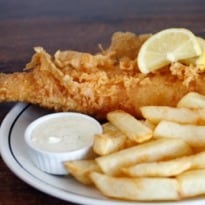Filling, nostalgic and utterly satisfying, fish and chips makes a fine meal any time of year, not just on Good Friday
Happiness is, with apologies to Pharrell, a fish and chip shop.
The smell of delicious things frying in hot oil. The implied nautical connection (even if you and your dog-eared copy of New Idea are passing time a hundred kilometres inland). The anticipation of that first mouthful of flaky white fish, quickly followed by a chaser of crunchy and fluffy potato. When it comes to things people want to eat, few foodstuffs are capable of outscoring fish and chips on taste, value and nostalgia.
While Greek Athanasias Comino opened Australia's first fish and chop shop in 1879, the dish's spiritual home is Britain, even though its two stars hail from elsewhere in Europe (although Jewish refugees from Spain and Portugal are credited with introducing fish-frying to Britain in the 16th century, the potato chip remains embroiled in a lengthy paternity hearing between the French and the Belgians).
Despite its foreign origins, the British have wholeheartedly made fish and chips their own. Last year, the National Federation of Fish Friers, Britain's representative body for the industry, celebrated the dish's centenary. Wartime prime minister Winston Churchill famously hailed the double-act as "good companions". In Frying Tonight: the Saga of Fish and Chips, Gerald Priestland tells the story of Operation Codpiece, an armoured fish and chip van launched by the British army to raise the morale of troops stationed in Ulster. Such is the power of fish, 'taters and - as is custom in the motherland - salt, malt vinegar and Yorkshire caviar (that's mushy peas to the uninitiated).
Based on my own travels, tartare sauce laced with capers appears to be Australia's condiment of choice: often found in fridges and occasionally home-made, they're a comelier prospect than those squeezy packets of shelf-stable mayonnaise found on countertops. At the risk of outing myself as a food heathen, I'm also partial to a decent squirt of tomato sauce on or by my chips. But regardless of one's sauce preferences, fried fish is best enjoyed sooner rather than later. Fish and chips might be takeaway royalty, but travel worse than a tired newborn. In a perfect world, every serve of fish and chips would be enjoyed while still hot and crunchy, preferably a stone's throw from the ocean the Australian-caught fish came from.
Unfortunately, the latter is rarely the case anymore. According to seafood authority John Susman of Fisheads Seafood Strategy, most of the fish sold as fish and chips comes from distant waters, with basa - a large, fast-growing fish farmed predominantly in Vietnam - most likely to be found in fry baskets around the country.
While this might be disheartening news for patriots, basa, hoki, southern blue whiting and the rest of the world's lower-priced Nemos help keep fish and chip prices affordable and in reach of most Australians. Additionally, these imported species also spells good news for those happy to eat outside of their comfort zones.
"Batter's a bit like bacon in that it makes everything taste nice," says Susman. "People shouldn't be afraid to mix things up and try things they haven't seen or tasted before. It surprises me that hake and hoki have got such a presence in the fish and chip trade because they're relatively stronger-flavoured fish. People who are prepared to try something with a bit more flavour should be able to have a crack at any number of species."
Fish and chips aren't just limited to corner stores and suburban delis, either. Riffing on the proven one-two of fried fish and tasty potatoes is a popular pastime among chefs in fine dining realms. One of my more memorable fish and chip experiences unfolded at Crown Melbourne's original Bistro Guillaume. Granted, the $45 I paid for "whole whiting with pommes Pont-Neuf and beurre maitre d'hotel" could have fed a couple of families at the local fry-shop, but after a fiery run-in with someone at one of the casino's other restaurants, it was a sum I gladly parted with. It was a small price to pay for the reassuring touch - and taste - of an old friend.
Photo: A plate of fish and chips. Photograph: Gary Calton







